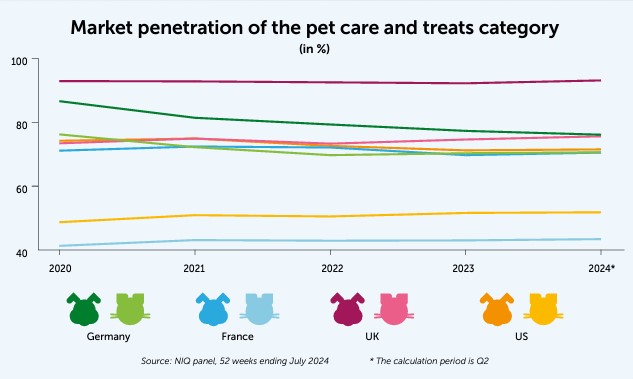Tracking the ups and downs of the snacks and treats market

While sales in European countries show generally positive growth figures, there is a slight downward trend in the US.
Since 2020, the global snacks and treats market for dogs and cats has seen robust growth, often achieving year-over-year increases in double digits. But recent developments indicate a significant slowdown, with growth in 2023 dipping to just 1.7%.
Challenges for global growth
The downturn in the global market can largely be attributed to the US, where sales in the category have contracted by 0.7%. North America is still the largest player in the snacks and treats market globally, with 65% of total market value.
That significant share means even small shifts in market dynamics have an outsized impact on global trends.
US influence has therefore diminished over the past 2 years, as it has lost 2 percentage points of its market share to Europe. Europe now holds 22% of the global market, underscoring its strengthening position.
The region has captured 45% of total units sold in the pet treats category, while the US represents 36% of worldwide sales.
Europe continues to exhibit positive growth trends, with the region expanding by 6.7% in 2023. Germany has emerged as a key driver of this, contributing significantly to overall European performance.
But while Europe remains a bright spot in the global market, its growth has begun to decelerate – from 12% a year ago.
This slowdown reflects broader economic challenges, including inflation, which have reshaped purchasing behavior as consumers become more selective in their spending.
Shifts in purchasing patterns
Differing trends in the US and Europe reflect the evolving dynamics of the snacks and treats market. Europe has emerged as the key contributor to global growth, benefiting from both price increases and steady sales volumes.
The US, while encountering some challenges with a slight decline in volume, continues to play a significant role in the market. This suggests that the region is adapting to the consumer behavior shifts influencing its current performance.
In Europe, treat products account for 18% of the total pet food portfolio. Despite the larger size of the cat main meal segment, dog treats hold 61% of the market compared to the 39% for cats.
However, cat owners are beginning to close the gap, with category sales growing at a rate of 13.3% (compared to 4% for dogs).
Consumer behavior in Europe
Countries within Europe exhibit varying trends in snacks and treats consumption. France and the UK have both seen increases in their long-term consumer bases, indicating steady demand.
On the contrary, Germany has experienced a decline in consumer interest, partly due to a shift in purchasing behavior during the COVID-19 pandemic, with many German pet owners now preferring online purchases to traditional retail buying.
Looking at specific spending habits, cat owners in the UK, France and Germany typically spend 30% less on treats per trip when compared with dog owners.
UK cat owners spend the most (€3.66/$4.07), followed by France (€3.50/$3,89) and Germany (€3.24/$3.60). UK consumers also tend to be more interested in snacks and treats in general, purchasing these products more frequently than their counterparts in other countries.
Dog owners not only spend more per trip than cat owners, but they also purchase the products more frequently. French owners spend an average of €5.02 ($5.58) on treats per trip, more than consumers in Germany (€4.48/$4.98) and the UK (€4.38/$4.87).
Looking at frequency, pet owners in the UK buy dog snacks and treats more often (15.3 times per year on average), followed by consumers in Germany (14.4) and France (9.1).
A market with opportunities
What indications do current trends give us for the future of the market? Europe is increasingly the driving force behind global market growth in snacks and treats for dogs and cats, supported by smaller contributions from Asia Pacific.
Over the past 2 years, European spending has increased, largely as a result of inflation, although growth has stabilized recently as consumers adjust to higher prices and become more cautious in their spending.
While the US faces challenges with declining sales, inflation has impacted the market across the board, leading to changes in purchasing habits and slowing growth.
However, with Europe continuing to post positive trends, and cat owners increasingly embracing pet treat products, the market still shows promise for future expansion.

